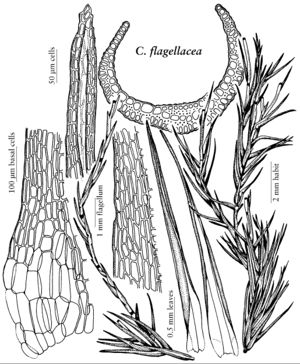Campylopodiella
Bull. Herb. Boissier, sér. 2, 8: 90. 1908 ,.
| Taxon | Illustrator ⠉ | |
|---|---|---|
 | Campylopodiella flagellacea | Patricia M. Eckel |
Plants in loose to compact tufts, 5–30 mm. Stems radiculose. Leaves erect-patent, lanceolate, ending in a long acumen, entire or with a few teeth at tips; costa filling 1/2–2/3 of the leaf base, excurrent, in transverse-section with large adaxial and abaxial hyalocysts, a median band of chlorocysts and 2–4 adaxial stereids; alar cells weakly developed; laminal cells long-rectangular. Sexual condition dioicous; perigonial leaves from broader base suddenly contracted into a slender subula. Seta yellowish or brownish in age, erect, twisted distally. Capsule erect, elliptic to cylindric, yellowish, without stomata; operculum long-rostrate; annulus present; peristome teeth 16, divided nearly to the base. Calyptra cucullate, fimbriate or entire at base. Spores 11–19 µm.
Distribution
North America, Mexico, Central America, South America, Asia
Discussion
Species 4 (2 in the flora).
The species listed here were previously included in the genus Atractylocarpus Mitten because of considerable confusion involved with the use of that generic name (J.-P. Frahm 2000). This was caused by the fact that the type species of Atractylocarpus turned out to belong to a genus later described as Campylopodiella. Therefore Frahm and P. Isoviita (1986) proposed conservation of the name Atractylocarpus, which was, however, rejected by the nomenclature committee at the International Botanical Congress in Tokyo. That decision was later corrected at the Congress in St. Louis, thus preserving the use of the name as proposed before, making new combinations unnecessary.
Campylopodiella comprises three species in the Himalayas, Central America, and northern South America, of which two have been found also in the flora area, each with one record. One species is also known from Eocene Baltic amber, which is presumably identical with the extant species from the Himalayas. The genus is characterized by a unique transverse section of the costa with a median band of chlorocysts and a few ventral stereids, which can be seen under the microscope without transverse section as dark band in the middle of the costa.
Selected References
None.
Key
| 1 | Alar cells distinct, inflated; leaves 5-8 times as long as wide; basal laminal cells in about 6 rows | Campylopodiella flagellacea |
| 1 | Alar cells indistinct; leaves 10-13 times longer than wide; basal laminal cells in 15-18 rows | Campylopodiella stenocarpa |